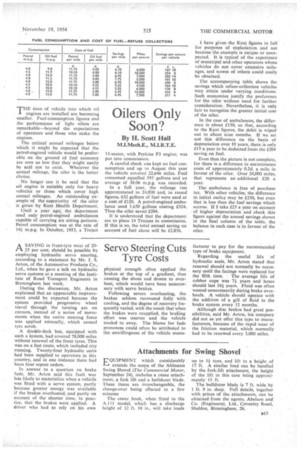Servo Steering Cuts Tyre Costs
Page 49

If you've noticed an error in this article please click here to report it so we can fix it.
ASAVING in front-tyre wear of 2025 per cent. should be possible by employing hydraulic servo steering, according to a statement by Mr. J. S. Arton, of the Automotive Products Co., Ltd., when he gave a talk on hydraulic servo systems at a meeting of the Institute of Road Transport Engineers in Birmingham last week.
During the discussion, Mr. Arton explained that an appreciable improvement could be expected because the system provided progressive wheel travel through the turning are on corners, instead of a series of movements when the entire steering force was applied Manually, which caused tyre scrub.
A double-deck bus, equipped with such a 'system, had covered 78,000 miles without renewal of the front tyres. This was on a fast route, which included city running. Twenty-four hydraulic units had been supplied to operators in this country, and in one instance there had been four repeat orders.
In answer to a question on brake fade, Mr. Arton said this fault was less likely to materialize when a vehicle was fitted with a servo system, partly because greater energy was available if the brakes overheated, and partly on account of the shorter time, in practice, that the brakes were applied. A driver who had to rely on his own
physical strength often applied the brakes at the top of a gradient, thus causing the shoes and drums to overheat, which would have been unnecessary with servo brakes.
Following severe overheating, the brakes seldom recovered fully with cooling, and the degree of recovery frequently varied, with the result that when the brakes were reapplied, the braking effort was uneven and the vehicle tended to sway. The blame for fade proneness could often be attributed to the unwillingness of the vehicle manu facturer to pay for the recommended type of brake equipment.
Regarding the useful life of hydraulic seals, Mr. Arton stated that renewal should not normally be necessary until the facings were replaced for the fifth time. The average life of rubber cups was 71 years and hoses should last 16i years. Fluid was often wasted unnecessarily during brake overhauls. A vehicle should operate with the addition of a gill of fluid to the brake system every 12 months.
Although disc brakes had great possibilities, said Mr. Arton, his company did not as yet offer this type to manufacturers, because of the rapid wear of the friction material, which normally had to be renewed every 3,000 miles.




































































































